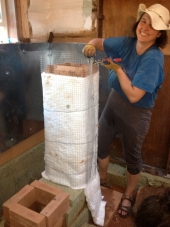I'm building a small all season recreational weekend type cabin for fishing, hunting, and snowmobiling, etc, in northern Minnesota on Sandy loam. The plan for water is to use jugs elevated above a sink. I want to upgrade from the 5 gal bucket under the sink and go with a drain pipe to the outside. I plan to run a pipe down about 30' to 50' to a dry well down slope. I'm wondering if I run the drain pipe from sink, no p-trap, straight through the floor with a 90° elbow to a pipe, buried in the ground then running down slope. Or, should I stay away from 90° elbow and go with a less sharp angle and use maybe a 45° elbow instead. Or, even go with flex pipe and no sharp angle at all? Of course, I need to be mindful with freezing temps that can go well below zero Fahrenheit at times but with the pipe buried and covered with mulch, etc, I don't expect freezing pipes to be problem as long as the slope is enough to keep water flushing down.


